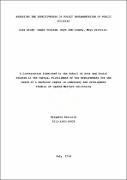Assessing the effectiveness of policy implementation of public policies
Abstract
Introduction: Head injury or traumatic brain injury (TBI) is an acute brain injury resulting from
mechanical energy to the head from an external physical force. It is a leading cause of death and
disability in children and adults in their most productive years. Types and causes vary from
population to population. Populations in urban locations are affected more than rural ones.
Management and outcome of TBI vary based on mechanism and severity of injury, location of
the lesion, and access to immediate, specialized management. Patient characteristics, timing and
accuracy of diagnosis also affect prognosis. The aim of this study was to determine the short
term treatment outcome of head injury patients in Nsambya Hospital.
Methods: We analyzed prospectively collected data from the surgical wards at Nsambya
Hospital for patients aged 18 years and above presenting with head injury between November
2014 and February 2015. A total of 108 patients were recruited in this study. They were assessed
for age sex, mechanism and severity of injury, associated injuries and investigations. Outcomes
of head injury were measured using the Disability Rating Scale and the Glasgow Outcome Score
at discharge or up to 28 days follow- up period.
Results: Patients with head injury (n=108) had more males (88.9%) than females (ratio 6:1). The
19-30 age group was mostly affected (51.9%). The major factors that influenced outcome
negatively were duration of stay and GCS at admission (p=<0.05).
Age, gender, mechanism of injury and associated injuries had no influence on the outcomes of
head injury in the short term.
Conclusion: The outcomes of traumatic brain injury are affected by GCS at admission but not
age, gender and mechanism of injury. DRS and GOS can be used in assessment of outcomes for
head injury


